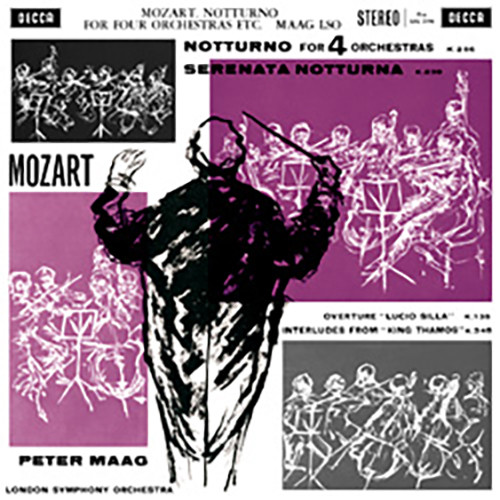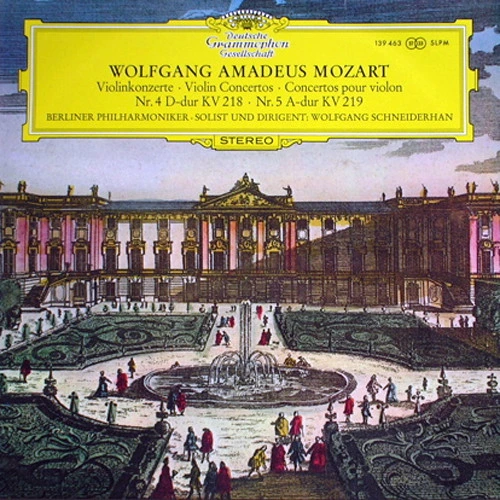180 Gram Virgin Vinyl! High Quality Pressing!
Bad weather in Salzburg, particularly during the dark and wet months of December and January, played a large role in the creation of Mozarts Notturni. Domestic music-making offered the upper classes a little cheer during the dreary winter months. Serenades by the Salzburg maestro were performed for entertainment and greatly influenced chamber and symphonic music.
The Overture to Lucio Silla is from an opera which tells the story of the bloody political dispute of the Roman general Lucio Silla. This highly developed work deviated from the norms of compositions, and this was perhaps the reason why it was not as popular in Milan as Mozarts other works with the result that he received no more commissions from Italian opera houses. The music written for the historical drama Thamos, König von Ägypten was unique for Mozart, although this kind of music was not unusual for its day. The so-called entractes served to fill the time between scenes or acts.
Peter Maag and the London Symphony Orchestra stage an excellent performance with their exquisite tone, exemplary dynamics and shaping of this wonderful music which reveals the splendidly colourful scores of one of the greatest musical phenomena: Wolfgang Amadeus Mozart.
Both the Serenata Notturna and the Notturno have three movements, although the number in this Serenade sort of work could be many more, and those three movements are anything but stereotyped - the Serenata consists of a March, a Minuet and a Rondo, the Notturno of an Andanate, and Allegretto grazioso and a Minuet. The instrumentation in the Notturno calls for four small orchestras of two horns and strings (eight horns in one work is quite a large collection) and in the Serenata for four solo strings (two violins, viola and unusually, double-bass) and a ripieno orchestra of strings and timapni. Mozart even makes experiments with sonorities (the pizzicato strings & timpani in the March of the Serenata, i.e.).
Features:
180 Gram Virgin Vinyl
High Quality Pressing
Pure Analogue Audiophile Mastering
Musicians:
Peter Maag, conductor
London Symphony Orchestra
Selections:
Wolfgang Amadeus Mozart (1756 - 1791)
Notturno for Four Orchestras
1. Andante
2. Allegretto garzioso
3. Minuetto
Serenata Nottuna
4. Marcia
5. Minuetto, Rondo
Overture To Lucio Silla
6. Molto Allegro
7. Andante
8. Molto Allegro
Interludes from Thamos Konig In Agypten
9. Maestoso
10. Andante
11. Allegro
12. Allegro vivace assai
Bad weather in Salzburg, particularly during the dark and wet months of December and January, played a large role in the creation of Mozarts Notturni. Domestic music-making offered the upper classes a little cheer during the dreary winter months. Serenades by the Salzburg maestro were performed for entertainment and greatly influenced chamber and symphonic music.
The Overture to Lucio Silla is from an opera which tells the story of the bloody political dispute of the Roman general Lucio Silla. This highly developed work deviated from the norms of compositions, and this was perhaps the reason why it was not as popular in Milan as Mozarts other works with the result that he received no more commissions from Italian opera houses. The music written for the historical drama Thamos, König von Ägypten was unique for Mozart, although this kind of music was not unusual for its day. The so-called entractes served to fill the time between scenes or acts.
Peter Maag and the London Symphony Orchestra stage an excellent performance with their exquisite tone, exemplary dynamics and shaping of this wonderful music which reveals the splendidly colourful scores of one of the greatest musical phenomena: Wolfgang Amadeus Mozart.
Both the Serenata Notturna and the Notturno have three movements, although the number in this Serenade sort of work could be many more, and those three movements are anything but stereotyped - the Serenata consists of a March, a Minuet and a Rondo, the Notturno of an Andanate, and Allegretto grazioso and a Minuet. The instrumentation in the Notturno calls for four small orchestras of two horns and strings (eight horns in one work is quite a large collection) and in the Serenata for four solo strings (two violins, viola and unusually, double-bass) and a ripieno orchestra of strings and timapni. Mozart even makes experiments with sonorities (the pizzicato strings & timpani in the March of the Serenata, i.e.).
Features:
180 Gram Virgin Vinyl
High Quality Pressing
Pure Analogue Audiophile Mastering
Musicians:
Peter Maag, conductor
London Symphony Orchestra
Selections:
Wolfgang Amadeus Mozart (1756 - 1791)
Notturno for Four Orchestras
1. Andante
2. Allegretto garzioso
3. Minuetto
Serenata Nottuna
4. Marcia
5. Minuetto, Rondo
Overture To Lucio Silla
6. Molto Allegro
7. Andante
8. Molto Allegro
Interludes from Thamos Konig In Agypten
9. Maestoso
10. Andante
11. Allegro
12. Allegro vivace assai



 Turntable Accessories
Turntable Accessories Headphone Accessories
Headphone Accessories Cable Accessories
Cable Accessories Vinyl Accessories
Vinyl Accessories Compact Disc Accessories
Compact Disc Accessories









